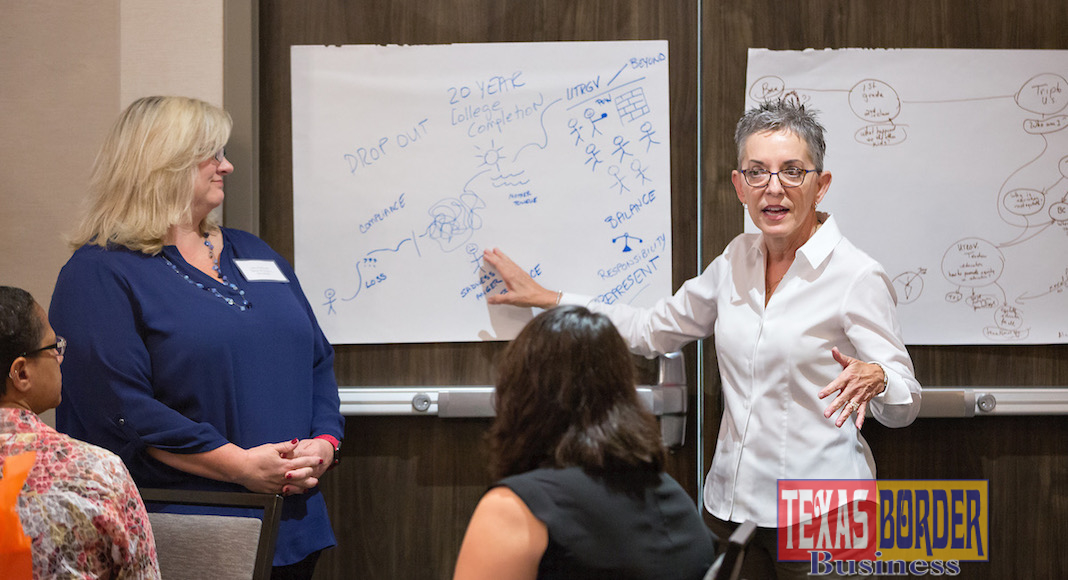
UTRGV Photo by Paul Chouy
Texas Border Business
By Amanda L. Alaniz
Rio Grande Valley, Texas – The UTRGV College of Education and P-16 Integration’s Hispanic-Serving College of Education Convening, held recently at the Cambria Hotel in McAllen, opened an important national dialogue about the university’s status and goals as a Hispanic-Serving College of Education.
The convening’s mission was to talk about what it means to be a Hispanic-Serving Institute (HSI), and invited representatives from 13 institutions of higher education and four professional organizations.
“The purpose of the event was to bring individuals from across the nation who are part of Hispanic-Serving Institutions, to engage in conversation about what it really means to be an HSI, beyond simply the percentage of students enrolled,” said Dr. Patricia Alvarez McHatton, UTRGV executive vice president of Academic Affairs, Student Success and P-16 Integration.
Institutions of higher education that enroll at least 25 percent Hispanic students earn the federal HSI designation, and UTRGV’s College of Education and P-16 Integration has a Hispanic student enrollment of about 92 percent.
The U.S. Department of Education offers eligible institutions, with the HSI designation, opportunities to apply for different grant programs, such as the Developing Hispanic-Serving Institutions Program.
Those attending were given markers and a piece of paper from an easel pad, and asked to write about their personal background. Then, each took a turn, sharing what they wrote and voicing their concerns and opinions about “What it means to be a Hispanic-Serving Institution.”
McHatton, Dr. Janine Schall, associate professor and chair of the UTRGV Department of Bilingual and Literacy Studies at the College of Education and P-16 Integration, and Eugenio Longoria Saenz, deputy director for RGV Focus, are the Hispanic-Serving College of Education Research Initiative facilitators.
The College of Education and P-16 Integration has been organizing the HSCOE project for about two and a half years, giving collaborative faculty groups opportunities to conduct research.
Several research projects have been funded by the initiative, seeking to address broad questions such as:
- How is a Hispanic Serving Institution different from other institutions?
- How do we support the identity that is being a Hispanic Serving Institution for UTRGV?
- What are initiatives within an HSI that can inform the work with educator preparation?
“Part of UTRGV’s mission statement, part of its plan, is to be a premier Hispanic Serving Institute. That’s written into the foundation of UTRGV,” Schall said.
“The issue moving forward is how do we make that meaningful? How do we make it not just a statement in a strategic plan somewhere? You walk onto campus and you feel this is a place that really values, addresses the needs of and honors our Hispanic students.”
Dr. Angela Chapman and Dr. Karin Lewis, assistant professors in the UTRGV Department of Teaching and Learning, were part of the first cohort when the HSCOE Initiative started nearly three years ago. Both said they’ve seen growth and positive changes within their college and in the research and the efforts of the initiative.
“Along this journey, we’ve created a space that has provided the SIRG (Special Interest Research Groups) an opportunity to carve out space to really explore. A lot of it we were floundering, floating around, and now we have a sense of this as a place where we belong,” Lewis said.
Chapman said their job is to prepare future teachers.
“And to me, that’s really been a transformative part of this,” she said. “I’ve been able to reflect on where I fit into this, on what I’m doing. But how do I take that into practice? When my students graduate and go into their classroom, how do they take with them what I’ve taught? I think that’s a very critical part.”
Lewis and Chapman both agreed HSCOE is significant, sparks an important conversation and is visionary, and anticipate a ripple effect within the university.
“I hope we can move this conversation beyond just our college and into our university,” Schall said. “We need to make it systemic and institutionalized. As UTRGV, who are we as a Hispanic-Serving Institution? Who do we want to be? What’s going to be the best for our students and faculty?”
Schall said they would like to make the convening a yearly event to help keep the conversation going and continue a lasting support system.
Visit Hispanic-Serving College of Education Research Initiative website to learn and explore more about the project.













